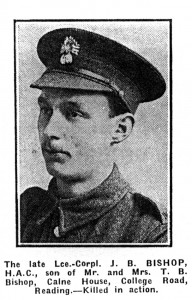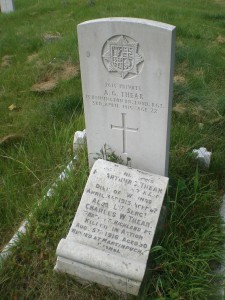John Bryan Bishop
Lance Corporal 4653
1st Battalion Honourable Artillery Company
 |
John Bishop was the son of Mr. Thomas Bryan Bishop and Mrs. Louisa Bishop, Calne House, 31. College Road. In the family he was referred to as Jack. He was described as a young man of fine character and a good soldier who was well liked by all. He was associated to both the King’s Road Baptist Church and also the Baptist Church in Kingston-upon-Thames where he worked. He was killed in action at Gavrelle on 24th May 1917, aged 23 years and is buried at Mindel Trench British Cemetery, St. Laurent – Blangly on the outskirts of Arras. The grave location is C. 18.
The Chronicle of June 22nd 1917 outlined the circumstances of his death when it published a letter sent to Rev. R. Gordon Fairbairn of the King’s Road Baptist Church, by a mutual friend. Jack “was killed the last time he was up in the trenches. I made enquires and found he never suffered at all, and that although he lived for a few minutes he was unconscious all the while. He was in charge of a party which went to draw rations. They were just taking them from the wagon when a shell burst in the village, and Jack had a bad wound in his leg, and before the doctor arrived he was dead. They did, of course, everything that was possible, but an artery was broken.”
Gavrelle was part of the Vimy battle field and a German front line position in April 1917. It was during the early actions described by Rose Coombs in “Before Endeavours Fade” that John Bishop lost his life. “Here was the scene of the attack by the 63rd Royal Naval Division* on April 23rd 1917 and their magnificent defence for many days thereafter through innumerable counter-attacks. It was held until the 56th London Division, which stubbornly defended it in March 1918, were overwhelmed on the 28th. The 51st Highland Division recaptured it on August 27th and it was occupied by the 8th Division”.
(*The 1st HAC battalion was attached to the 63rd Royal Naval Division at the time of John Bishop death.)
A further reminder of the struggle which took place on the battle fields around Arras is also located in St. Laurent- Blangly, here lies the large German cemetery where over 31,000 men are commemorated, many in a mass grave.


